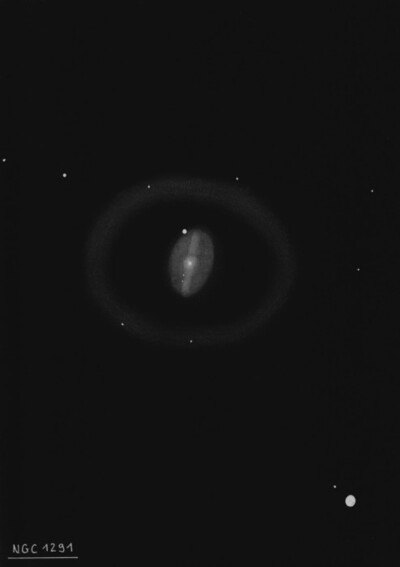
James Dunlop discovered NGC 1291 = D 487 = h2521 on 2 Sep 1826 with his 9" reflector at Parramatta and recorded "a pretty bright round nebula, about 1.5' diameter, very bright and condensed to the centre, and very faint at the margin; with a very small star about 1' north, but not involved.". His position is 4' too far ESE. John Herschel observed this galaxy on 1 Nov 1836 and also catalogued h2518 (later NGC 1269). The declination and descriptions are identical for his two entries, but differ by 2.6 minutes of time. Clearly, Herschel was confused and recorded the object twice. So, NGC 1269 = NGC 1291.
On a second sweep Herschel described the galaxy as "Globular; vB, R, 1st gradually, then suddenly very mbM; r, mottled, but not resolved.", so Dreyer identified this galaxy as a globular in the NGC description. In a 1908 paper in Annals of the Harvard College Observatory, Solon Bailey expressed his doubt on the object's nature: "This object is given as a globular cluster in the NGC. This appears probable, although it is not resolved on the [24"] Bruce plates [at Arequipa]." He later included it in a list of uncertain or not probable globular star cluster.
Based on the photographs taken 30-inch reflector at the Cordoba observatory in Argentina, Charles Perrine first described the large outer ring in 1922 as "about one and one-half turns of a helix, the doubled portion (showing two streams) being to the north of the nuclear portion of the nebula. The diameter of the helix is about 7'."
300/350mm - 13.1" (10/10/86): very bright, moderately large, round, very bright core, almost stellar nucleus, large faint halo. A star is involved on the north side.
400/500mm - 17.5" (8/31/86): very bright, fairly large, contains a very bright, large core. A mag 12 star is just off the north end 1.7' from the center. Mag 8 SAO 216239 lies 11' SSW. Viewed at only 10? elevation.
600/800mm - 25" (3/31/19 - OzSky): at 244x; extremely bright, large, elongated 4:3 NNW-SSE, ~3.5'x2.7', very bright core with an intense nucleus. A mag 12.2 star is is superimposed at the N edge 1.7' from center and a second very faint star is superimposed in the halo on the south side. The huge outer ring was not noticed.
Notes by Steve Gottlieb